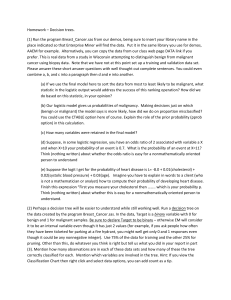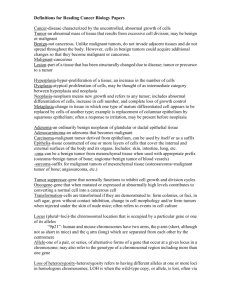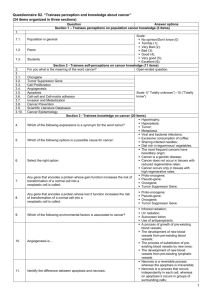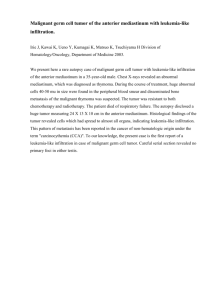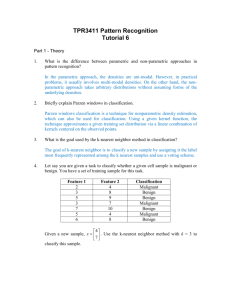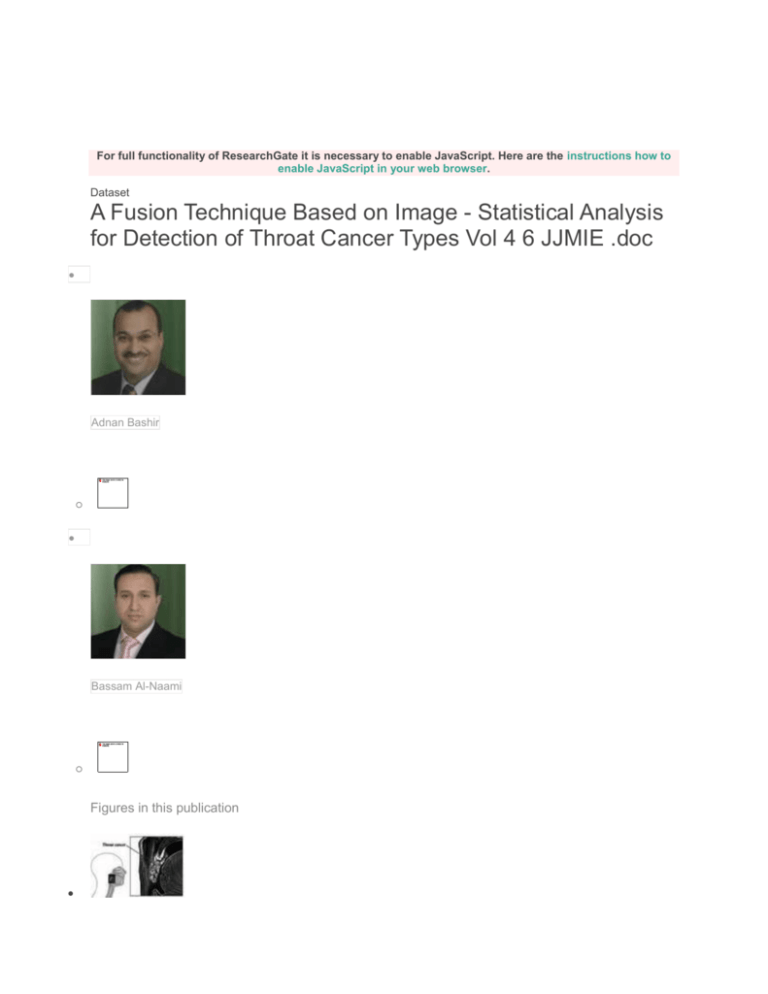
For full functionality of ResearchGate it is necessary to enable JavaScript. Here are the instructions how to
enable JavaScript in your web browser.
Dataset
A Fusion Technique Based on Image - Statistical Analysis
for Detection of Throat Cancer Types Vol 4 6 JJMIE .doc
Adnan Bashir
o
Bassam Al-Naami
o
Figures in this publication
Get notified about updates to this publication
Follow publication
Download full-text
Full-text
Available from: Bassam Al-Naami
SHARE
Page 1
JJMIE
Jordan Journal of Mechanical and Industrial Engineering www.jjmie.hu.edu.jo
Volume 4, Number 6, December 2010
ISSN 1995-6665
Pages 677 - 684
A Fusion Technique Based on Image - Statistical Analysis for
Detection of Throat Cancer Types
Department of Industr15, Jordan
Department of Biomedical Engineering, Hashemite University, P.O. Box 150459, Zarqa 13115, Jordan
Abstract
Adnan Al-Bashir a,*, Bassam Al-Naami b
ial Engineering, Hashemite University, P.O. Box 150459, Zarqa 131
The aim of this study is to establish a simple approach to classify the throat tumor type by using statistical analysis
techniques
witho for a biopsy or further testing. In this study, around 35 patients were investigated to be classified and to
provide appropriate diagnostic for the throat cancer type. MRI images and their properties were processed and
converted into
numb
inform
Hypo
that t
the th
roat cancer with 95% confidence.
Keywords: Throat cancer (TCa), filtration, segmentation, box plot, T-test,
ut a need
er of pixels and intensities that located in the region of interest which covered the area of tumor. This extracted
ation was employed by traditional statistical methods such as Descriptive Analysis, Box Plots and Testing of
thesis to enable reasonable accuracy in differentiation between the tumor types. As a result of this study, it is
observed
he using of statistical analysis for the data taken from the MRI images is reliable to diagnose and determine the type
of
© 2010 Jordan Journal of Mechanical and Industrial Engineering. All rights reserved
Inter Quartile Range (IQR) .
1. Introduction *
t dangerous cancer's
type and forms in tissues of the pharynx (the hollow tube
inside th
top
includ
throa
the ph
phary
includ
squam
cells
cance
cance
State
(phar
and 2
In
Registry
regist
per 1
femal
Jorda
as the eighth common type in children and the 10th in
Jordan National Cancer
* Corresponding author. abashir@hu.edu.jo
Throat cancer is one of the mos
e neck that starts behind the nose and ends at the
of the windpipe and esophagus). Throat cancer
es cancer of the nasopharynx (the upper part of the
t behind the nose), the oropharynx (the middle part of
arynx), and the hyp-opharynx (the bottom part of the
nx). Cancer of the larynx (voice box) may also be
ed as a type of throat cancer. Most throat cancers are
ous cell carcinomas (cancer that begins in thin, flat
that look like fish scales). Also called pharyngeal
r (Fig.1) Estimated new cases and deaths from throat
r (including cancers of the larynx) in the United
s in 2009 are 12,290 (laryngeal) and 12,610
yngeal), while the death cases are 3,660 (laryngeal)
,230 (pharyngeal) [1].
2004, according to the
, (JNCR), about 3,591 new cancer cases have been
ered among Jordanians with an incidence rate of 67.1
00,000 populations (63.9 for males and 70.5 for
es). Among the most common cancers affecting
nian population, the throat tumor (TCa) was ranked
males 3.5% more than females
at
tumo
th
h
y
la
a
g
ca
to
ti
b
cancerous.
However, it is important in many cases to validate a
agnosis and be certain of its accuracy. On the other hand,
oping for a misdiagnosis should not be used as a way to
oid treatment for a serious medical problem as the throat
ncer. Nevertheless, it is sensible to attempt to confirm a
iagnosis via methods such as seeking second opinions,
nsulting specialists, getting further medical tests, and
searching information about the medical condition. Also,
isdiagnosis can and does occur and is reasonably
mmon with error rates ranging from 1.4% in cancer
iopsies to a high 20-40% misdiagnosis rate in emergency
r ICU care.
[http://www.cureresearch.com/intro/overview.htm].
rentiate between the benign and malignant
r such as: 1) Physical exam. 2) Indirect laryngoscopy;
e doctor looks down your throat using a small, longandled mirror to check for abnormal areas and to see if
our vocal cords move as they should. 3) Direc
ryngoscopy; the doctor inserts a thin, lighted tube called
laryngoscope through your nose or mouth. As the tube
oes down your throat, the doctor can look at areas that
nnot be seen with a mirror. 4) Biopsy is removing tissue
look for cancer cells and a pathologist then looks at the
ssue under a microscope to check for cancer cells [1]. A
iopsy is the only sure way to know if a tumor is
t
di
h
av
ca
d
co
re
m
co
b
o
adults and the prevalence in
(2.1%) [2].
Different diagnostic procedures have been followed in
tempt to diffe
Page 2
© 2010 Jordan Journal of Mechanical and Industrial Engineering. All rights reserved - Volume 4, Number 6 (ISSN
1995-6665)
678
Therefore, in this paper, we focused on building an
algorithm – software based on the use of LabView
software to analyze the image of Throat Cancer, where
part of this technique was tested in our previous work for
brain tum
the d
filteri
techn
inten
Malig
analy
V
been
proce
TCa
into:
1)
for T
5, 6,
In [4]
diver
devele system takes as input an approximate
bounding
the f
segm
stand
radio
comp
mm c
autom
well.
dime
autom
The p
segme
step b
this a
Shipi
that e
this a
estim
of its
grays
as an
that t
edge,
pixel
pixel
devel
imag
tissue
extra
impro
in or
statis
the us
Statistical methods represent another important
category
appro
statis
proce
[3, 8,
One of the reliable and suited MRI and CT
segmentation techniques is the region growing that can be
applied to TCa tumor is generally, presented in many
studies [3 and 11-16]. Cheng-Long Chuang et al. proposed
an
ex
in
M
th
in
al
q
d
ra
diologist to treatment [16].
This paper is organized as following: a review about
e TCa types and the related work was presented. A
etailed description of image preprocessing and extraction
rameters from the ROI, data collection, and statistical
alysis for the collected data is described in second
ction. The last section describes the experimental results
d discussion and concludes the paper along with outline
ture direction.
th
d
pa
an
se
an
fu
2.
In this study, the processed images of TCa are divided
roups:
The first group
is representing the sample of 21 (n1)
ages which was already diagnosed as a malignant tumor
and the second group is representing the sample of 12
2) diagnosed as benign tumor were collected randomly.
ll data were provided by the Hussein Medical City
im
,
(n
A
hospitals and the Islamic hospital in 2006 and 2007
re
d
p
A
la
b
p
th
to
w
and be supporting technique for the physicians.
.1. Preprocessing of image data
2
and treated by applying
the s
•
• Enhancement image to improve quali
• Image segmentation to find the region of
(ROI).
• Histogram of region of
• Apply statically process on (ROI) to fi
result that we need to make the comparison betwe
malignant and benign tumors based on the use of tes
hypothesis.
The tumor of TCa is surrounding b
ck (nasopharynx, oropharynx, pharynx and the hyppharynx) that looks like tumor in the normal form.
ence, the region that covers the tumor should be carefully
hanced and improved so that after applying the
ty
interest
interest (ROI)
nd the final
en
t of
y others part of the
ne
o
H
en
or classification [3]. This target was achieved by
eveloped algorithm consisted of image enhancement,
ng and applying the region of interest threshold
iques to extract the number of pixels and their
sities for both types of throat cancers (benign and
nant). This procedure is followed by the statistical
sis based on Box Plot and Test of Hypothesis.
arious segmentation techniques and methods have
cited in the literature for improving the segmentation
sses to maximize the possibility and reliability of
classification. These techniques can be categorized
threshold-based segmentation, 2) statistical methods
Ca segmentation and 3) region growing methods [4,
7].
a semiautomatic system for segmentation of a
se set of lesions in head and neck CT scans has
oped. Th
box, and uses a multistage level set to perform
inal segmentation. Then contours from automatic
entation were compared to both 2D and 3D gold
ard contours manually drawn by three experienced
logists. The average absolute area error was 21.1%
ared to 10.8%, and the average 2D distance was 1.38
ompared to 0.84 mm between the radiologists. The
atic contours approximated many of the lesions very
Haibo Zhang et al. developed a new threensional adaptive region growing algorithm for the
atic segmentation of three-dimensional images [5].
rinciple of this algorithm is to obtain a satisfactory
nt result by self-tuning the homogeneity constraint
y step. Results of segmentation based on the use of
lgorithm are close to that of manual segmentation.
ng Zhu et al. proposed a new segmentation algorithm
ach pixel in the image has its own threshold [6]. In
lgorithm, the threshold of a pixel in an image is
ated by calculating the mean of the grayscale values
neighbor pixels, and the square variance of the
cale values of the neighbor pixels are also calculated
additional judge condition. The results demonstrate
he proposed algorithm could produce precise image
while it is reasonable to estimate the threshold of a
through the statistical information of its neighbor
s. In [7] a novel object identification algorithm was
oped in Java to locate immune and cancer cells in
es of immune histochemically- stained lymph node
. This algorithm focuses on the interactive feature
ction from color images, so that the classification is
ved with an interactive visualization system. Then,
der to increase the accuracy it coupled with the
tical learning algorithms and intensive feedback from
er.
in the segmentation process and most of the
aches proposed in this category were using some
tical classifications combined with different image
ssing techniques in order to segment the MRI images
9, and 10].
image-based object segmentation algorithm for
tracting tumor-like objects in CT images based on
tensity regions automatically in a CT volume image [15].
ancas et al. provided segmentation using region growing
reshold; this technique used threshold and spatial
formation to segment the region of interest [11]. Jiang et
. also provided producer for segmentation and
uantification of brain tumor, by semi automatically
etecting the area of the tumor in the brain that help the
Methodology
into two different g
spectively, Amman, Jordan. The common procedure of
etermining throat tumor type was by examining the
atient’s MRI images by an experienced radiologist.
ccording to these comments, that would be our reference
ter on, the type of tumor will be decided which may not
e accurate as mentioned above as misdiagnoses. Our
roposed approach is about using the statistical analysis of
e data obtained form MRI images and makes inferences
distinguish between the two different types of tumor
hich may be more accurate than the traditional method
MRI image should be prepared
teps:
Convert all images to the gray scale
Page 3
© 2010 Jordan Journal of Mechanical and Industrial Engineering. All rights reserved - Volume 4, Number 6 (ISSN
1995-6665)
679
Figure 1: Throat Cancer Tumor
technique we could extract the n
tely.
images characteristics such a small size, or Some f the
low c
using
image
origin
param
consi
pass
Softw
not c
throu
filter
with
pass
reduc
The n
In
patien
regions in the image to discover the type of the tumor. So,
segment thes
process is to divide an im
constituents regions or objects, then take
it
p
n
umber of pixels in each grayscale value and graphs it.
.2. Statistical Analysis
2
ll be demonstrated in
the d
an
st
an
sample t- test.
The test statistics is a single number that calculated
om the sample
tion region or in the acceptance region. Depending on
e location of test statistics the null hypothesis could be
jected or accepted as illustrated in figure 2.
fr
rejec
th
re
mean, which can be loca
segmentation
features accura
of the
e regions.
age into its
a specific region;
ted.
two ways;
ted in the
eeded the diagnostic depends on
Segmentation
o
ontrast can be seen, but this problem was solved by
the special low pass filter. The clarity of the filtered
depends on many factors such as filter mask,
al image, boundary option and the standard
eter called alpha. These entire factors were
dered in performing the filtration process. The low
filter is used and implemented using the LabView
are. It allows low frequency data, or data that does
hange much from pixel to neighboring pixel, to pass
gh, For an image that contains a lot of noise, such a
would smooth out the image and reduce the noise
minimal affect on large features in the image. A low
filter will affect large features in the image, and will
e or eliminate the smaller features [17, 3].
ext step is the image segmentation.
the normal cases, when the throat image
t arrives to the radiologist, he studies the up normal
is called the region of interest (ROI). Histogram is a
rocess followed by segmentation. It counts the total
For each MRI image the data is collected and tabula
Analysis of such data wi
escriptive analysis utilizing the Box Plot presentation,
d the testing of hypotheses approach. A hypothesis
ated that there is no difference between the malignant
d benign will be tested using the difference between two
Figure 2: Rejection and acceptance regions for one tail and 2-tail test
Page 4
© 2010 Jordan Journal of Mechanical and Industrial Engineering. All rights reserved - Volume 4, Number 6 (ISSN
1995-6665)
680
Applying the test of hypotheses is done by following
these steps [18-20]:
• Null hypotheses Ho :( µm- µb ) =D0, where D0 is some
difference between the mean values .and we will
consi
Te st statistics (t
)
0
der D0 =0.
)
21
(
−−
=
DXX
t
21
0
+
nn
p
S
(1)
11
2
)1
−
()1
−
(
21
2
22
2
11
−+
+
n
=
n
snsn
sp
(2)
Where Sp: pooled standard deviation.
: degree of freedom;
f
2
−+=
nn
f
d The critical value
on α (type I error
• Compare the two values of the test and decide on H0
(3)
• Finof
d
d
21
2
αα
t ort
depending
3.1. Image Preparation
the image processing result for
malignant and benign tumors respectively contain filtered
the selected ROI that contain
man
h
d
m
alignant or benign.
)
3. Result and Analysis
Figures 3 and 4 show
image and histogram for
y statistical variables. It is noted that the output image
ave higher quality than input image, also there is no
ifference between applying the enhancement on
Fig. 3 Image processing result of malignant tumor
Page 5
© 2010 Jordan Journal of Mechanical and Industrial Engineering. All rights reserved - Volume 4, Number 6 (ISSN
1995-6665)
681
By comparing figure 3 and figure 4,
histogram for ROI in both malignant and b
are diffe
malig
histog
ram of region of interest in benign image
4. St
im
two stages; the first stage is the desc
construct
while
hypo
4.1. D
escriptive Result
he sta
range fo
for th
differ
many
imag
analysis
21 im
Th
mean va
benig
was 9
also
benig
a difference in the
av
b
ty
th
m
Fig. 4 Image processing result of benign tumor
the tw
enign tumors
ages data was performed in
riptive analysis and
ndard deviation and the
descriptive
age mean of the pixel is below from
100.
results that the average value of the malignant tumor
which are in the range of (80-115) is higher than the
av
o
f (22-58).
The mean value for the maximum values in malignant
ages was 2
es in benign was 163. The standard deviation and
edian for the malignant is higher than the benign images.
oreover, the maximum and minimum in the malignant is
igher than the benign. All the above descriptive give an
dication that the malignant images are differ from the
enign.
The Box Plot in figure 6, clearly indicates the same
sults explained in table 1, that is the maximum values of
e malignant tumor which are in the range of (208-256) is
igher than the maximum values of the benign tumor
hich are in the range of (135-190).
The difference between the tw
ous as is shown in the figures above since the
alignant images have a box plot with higher range and
igher spread than the benign box plot. Considering the
erage pixel value to be the criterion to distinguish
etween the two tumors types, it is clear that the malignant
pe have greater pixel values than the benign one. Also,
e dispersion for the benign tumor is smaller than the
alignant one.
im
valu
m
M
h
in
b
27, while the mean value for the maximum
re
th
h
w
o samples is clearly
obvi
m
h
o figures, the tumor and the aver
rent, since the histogram of region of interest in
nant image reaches high level of pixel value than the
atistical Result
Statistical analysis for all
ion of the box plot for each type of the tumor,
the second stage id to perform the testing of
thesis on the mean of the two types.
The average pixel value, t
r the malignant and for the benign were calculated
e two sample data available. it is noted that there is a
ence between the malignant and benign image in
parameters such as, the mean pixel for the malignant
e is higher than in the benign images.
Table 1 shows the summary of the
for the maximum and average pixel values in all
ages and 12 benign images.
e above table shows that there is
lue of the averages between the malignant and the
n tumor images. The mean for the malignant images
5.58 while it was 40.1 for the benign images. It is
noted that the value of the maximum number in
n tumor is small than max value of the malignant
The Box Plot in figure 5, clearly indicates the same
erage values of the benign tumor which are in the range
Page 6
© 2010 Jordan Journal of Mechanical and Industrial Engineering. All rights reserved - Volume 4, Number 6 (ISSN
1995-6665)
682
Table:1 Statistical parameters for maximum and average pixel values for malignant and benign
Subject Maximum Pixel Values Average Pixel Values
Parameters Malignant Tumor Benign tumor Malignant Tumor Benign tumor
Mean 40.1 226.76 163.33 95.58
Maxim 255 120. .29 um 206 93 73
Minimum 177 123 50.11 14.5
Standard deviation 22 6.6 9.85 20.02 19.28
Variance 707.890.79 97 400.7 371.85
The lower q) 203.134.77. uartile (Q15 5 93 23.33
the upper qu 251 191. 114. artile (Q3)5 02 53.09
Range 78 83 70.82 59.04
Average No. of Pixels
benign_ 1 malignant_ 1
benign_ 1 malignant_ 1
120
100
80
60
40
20
0
120
100
80
60
40
20
0
Average Pixel Va
Figure 5: Box plot for the average pixel values
lue
Max. No. of Pixels
benignmalignant
benign malignant
260
240
220
200
180
160
140
120
260
240
220
200
180
160
140
120
Maximum Pixel Values
Figur
e 6: Box plot for the maximum pixel values
Page 7
© 2010 Jordan Journal of Mechanical and Industrial Engineering. All rights reserved - Volume 4, Number 6 (ISSN
1995-6665)
683
4.2. Testing of the Hypothesis
In the pervious section, the information in table 1, is
needed t m the test of hypothesis that say the mean o perfor
of maximum number of pixel and the mean of
number of pixels in the malignan
benign ones .A two sample t – test will be used
se the number of the two sample is different and the
les were drawn from a population with unknown
ces. .
averag
t tumor is higher th
from the
becau
samp
varian
4.2.1
pixel
In order to make a conclusive decision about the
difference between the malignant and the benign images,
the null hypothesis is tested against the alternative one as
below:
H0 : (
Ha : (μm ≠ μb),
: HWhe
H : is
a
the al rnati
μm
gmali nant images
μb
benign i
Since
appro
two
hypo
reject
samp
to cal
Table 2: Parameters used in the t test
e
an
. Test of the hypothesis for mean average number of
μm =μb)
e null hypothesis
vepothesis
hy
of the average number of pixels in
te
re
0: is th
is the mean
number of pixels in
ples have a probability plot
Value
is the mean of the average
mages.
the two sam
ximately linear, the (t) test for difference between
sample means will be used in testing the null
thesis. If t- calculated value> t- tabulated value, we
H0 and accept H1. The results for using the two
le (t) test are shown below; these parameters are used
culate the (t) statistics.
Parameters
Mean 226 of M .8
Mean 163 of B .3
Standard deviation Sm 26.6
Stand29.ard deviation SB 8
t- ca6.3lculated value 1
Pooled sta79ndard deviation Sp 27.91
S0ignificant level α .05
t- tab1.69ulated value 6
Degree 3of freedom dƒ 1
Numb21 er of sample n1
Numb 12 er of sample n2
From table 2, the t- calculated value (6.31) > ttabulated
locate
hypo
differ
mean
mean
the n
avera ge value of the number of pixel of benign.
4.3. Test of the hypothesis for mean maximum number of
pixel
Another important testing of hypothesis is that whether
the maximum pixel value of the malignant is equal to th
maximum pixel value of the benign image.
H0 : (μmm μ
=
mb
a(
here: HW
H : is the alternative hypothesis
a
μ
mm
ages im
μ
: is the mean of max. Pixel
mb
. The d taa and the results for using the two sample (t) test
e shown below; these parameters are used to calculate
t) statistics.
able 3: Parameters used in the t test
e
)
H : μmm >μmb),
0: is the null hypothesis
value (1.696), and since the t (calculated) is
d in the rejection region, we reject the null
theses H0 and strongly conclude that there is a
ence between the mean value of malignant and the
value of benign images with 95% confidence, this
s that type I error is 0.05. Then the average value of
umber of pixel of malignant tumor is higher than the
: s thei ean m of max. Pixel value in malignant
value of benign images
ar
the (
T
Parameters Value
Mean of M 95.6
Mean of B 38.5
Standar Sm 20 d deviation
Standar SB d deviation19.3
t- calculated value 7.98
Pool
p 1 1 ed standard deviation S 9.760
Significant level α 0.05
t- tabulated value 1.309
Degree of freedom dƒ 31
Number of sample n1 21
Number of sample n2 12
From calculated va.98)> ttabulated value (1.309) and since the t(measured) is
locat
hy
p
p
th
m
value of the number of pixel of benign.
5.
y, our goal is to automatically and In this stud
tically diagnose the type of tumor in the throat by
sing MR images. In order to do this, we addressed simple
ox plot technique to differentiate between the two types.
lso, testing of hypothesis was applied for the same
urpose. Region of interest, filtration and segmentation
chniques were utilized to be the base of the information
get the statistical data for each case. It has been proven
at a simple, harmless and accurate statistical technique
n efficiently distinguish between the malignant and
enign tumor (TCa). The huge advantage of this approach
that there will be no need to make any further tests or
aminations on the patient after making the MRI. Some
statis
u
b
A
p
te
to
th
ca
b
is
ex
the table the t-lue (7
ed in the rejection region, we reject the null
potheses H0 and strongly conclude that the maximum
ixel value for malignant is greater than the maximum
ixel value for benign images with 95% confidence. Then
e average of average value of the number of pixel of
alignant tumor is higher than the average of average
Conclusion
Page 8
© 2010 Jordan Journal of Mechanical and Industrial Engineering. All rights reserved - Volume 4, Number 6 (ISSN
1995-6665)
684
of these tests or examinations are difficult to be performed
or may be dangerous such as throat biopsy.
The diagnosis system achieves accuracy over 95.0% in
differentiation between the different tumor types on
vario
satisf
needs to
appli
the o
future
in m
accur
So
the o
differ
sugge
study
Th
devel
databere, this simple and fast diagnosis method
may be u
datab
the p
datab
ases.
system still
Refer
[1] National Cancer Institute, USA. http://www.cancer.gov.
[2] King Hussein Cancer Centre, Jordan. http://www.khcc.jo.
r Segmentation of Three-dimensional Medical
Images". Sixth International Conference on Parallel and
Distributed Computing Applications and Technologies
(PDCAT'05), Dalian, China, 2005.
[7] H. Susan, K. Adam and P. Peter, "An Interactive Java
Statistical Image Segmentation System". GemIdent, Journal
of Statistical Software, Vol. 30, No 10, 2009, 1-20.
[8] M. Justin, K. Iftekharuddin, "Statistical analysis of fractalbased brain tumor detection algorithms". Magnetic resonance
imaging, Vol. 23, No. 5, 2005, 671-678.
ristos,
2-763.
C, Canada,
& Engineering, Vol. 9, No. 4, 2007, 32 – 38.
uantification of brain tumor, Virtual
ronments". IEEE Symposium on Human-Computer
Interfaces and Measurement Systems, Boston, USA, 2004.
all,
Edition, John
ontgomery, Probability and
us qualities of MR images. Although some
actory results are obtained, the diagnosis
be improved. The results of the experiments and
cation of the proposed method may also be applied to
ther areas of medical image analysis. So, another
task is to apply this proposed method to other areas
edical image analysis to improve the achieved
acy in this study and the previous one in [3].
me weaknesses of the algorithm are the small area of
verlap between the extreme values of the two
ent tumor types. To overcome this drawback, it is
sted to increase the number of samples used for the
.
is automatic statistically based diagnosis method is
oped to classify the images of large medical
ases. H
sed to extract information from the large medical
ases. An important future work would be measuring
erformance of this method in mining medical
ences
[3] B. Al-Naami, A. Bashir, H. Amasha, J. Al-Nabulsi, and A.
Almalty, "Statistical Approach
Classification Using a Region Growing Threshold". Journal
od Medical Systems, DOI: 10.1007/s10916-009-9382-6.
Pre
Biomedical Engineering. IFMBE Proceedings, Vol. 14, No.
4, 2006, 2488-2492.
for Brain Cancer
[4] S. Ethan, H. Lubomir, S. Berkman, G. Sachin, I. Mohannad,
K. Suresh and C. Heang-Ping, "Automated volume analysis
of head and neck lesions on CT scans using 3D level set
segmentation". Med Phys. Vol. 34, No. 11, 2007, 4399–
4408.
Envi
[5] Z. Haibo, S. Hong, D. Huichuan, "An Automatic and Robust
Algorithm fo
[6] Z. Shiping, X. Xi, Z. Qingrong, B. Kamel, "An Image
Segmentation Algorithm in Image Processing Based on
Threshold Segmentation".
Conference on Signal-Image Technologies and InternetBased System, Shanghai, Chaina, 2007.
Third International IEEE
[9] M. Ashraf, I. Evangelia, S. Dinggang, D. Ch
"Deformable registration of brain tumor images via a
statistical model of tumor-induced deformation". Medical
Image Analysis, Vol. 10, No. 5, 2006, 75
[10] X. Xiao, L. Qingmin, "Statistical Structure Analysis in MRI
Brain Tumor Segmentation. Image and Graphics", ICIG.
Fourth International Conference, Sichuan, Chaina, 2007.
[11] M. Mancas, B. Gosselin, B. Macq, "Segmentation Using a
Region Growing Thresholding", Proc. of the Electronic
Imaging Conference of the International Society for Optical
Imaging SPIE., San Jose (California, USA), 2005.
[12] M. Sezgin, B. Sankur, "Survey over image thresholding
techniques and quantitative performance evaluation". J.
Electron. Imaging Vol. 13, No. 1, 2004, 146-165.
[13] M. Chowdhury, W. Little, "Image thresholding techniques"
IEEE Pacific Rim Conference on Communications,
Computers, and Signal Processing, Victoria, B
1995.
[14] Z. Pan, L. Jianfeng, "A Bayes-Based Region-Growing
Algorithm for Medical Image Segmentation. Computing in
Science
[15] C. Cheng-Long, and C. Chun-Ming "A Novel Region-based
Approach for Extracting Brain Tumor in CT Images with
cision. World Congress on Medical Physics and
[16] J. Chunyan, Z. Xinhua, H. Wanjun, C, Meinel,
"Segmentation and q
[17] Rafael C. Gonzalez, Richard E. Woods and Steven L. Eddins.
Digital image processing, Second Edition , Prentice H
Upper saddle River, new Jersey, USA, 2004.
[18] Doouglas C. Montgomry and George C. Runger; Applied
Statistics and Propability for Engineers, Fourth
Wiley and Sons, New York, USA, 2008.
[19] Ronald E. Walpole, Roymond H. Myers, Sharon L. Myers
and Keying YE; Probability and statistics for Engineering
and Scientists, Eighth Edition, Prentice Hall, Upper saddle
River, new Jersey, USA, 2008.
[20] Williams W. Hines and D. M
Statistics in Engineering and Management Science, Forth
edition, John Wiley & Sons, Inc., New York, USA 2006.
Download full-text
View other sources
Hide other sources
A Fusion Technique Based on Image - Statistical An...
Available from Bassam Al-Naami · May 27, 2014
Data provided are for informational purposes only. Although carefully collected, accuracy cannot be guaranteed. The
impact factor represents a rough estimation of the journal's impact factor and does not reflect the actual current
impact factor. Publisher conditions are provided by RoMEO. Differing provisions from the publisher's actual policy or
licence agreement may be applicable.
REFERENCES (12)
CITED IN (0)
o
o
Sorted by: Order of availability
Order of availability
Appearance in publication
Supplementary to (1)
A Fusio... Types
SIMILAR PUBLICATIONS
Image fusion technique based on non-subsampled contourlet transform and adaptive unit-fast-linking pulsecoupled neural network
W. W. Kong, Y.J. Lei, S. Lu
Vegetation change detection based on image fusion technique
Yonghong Jia, Yueyan Liu, Hui Yu, Deren Li
Statistical analysis of threshold algorithms in image processing based cancer cell detection
Gamze Koc, Baykal Sarioglu
© 2008‐2016 researchgate.net. All rights reserved. About us · Contact
us · Careers · Developers · News · Privacy · Terms | Advertising · Recruiting
We use cookies to give you the best possible experience on ResearchGate. Read our cookies policy to learn more.
Ok
Join for free
Log in
Top of Form
Email
Password Forgot password?
Keep me logged in
Log in
Bottom of Form
or log in with
ResearchGate is the professional network for scientists and researchers.
Join for free




